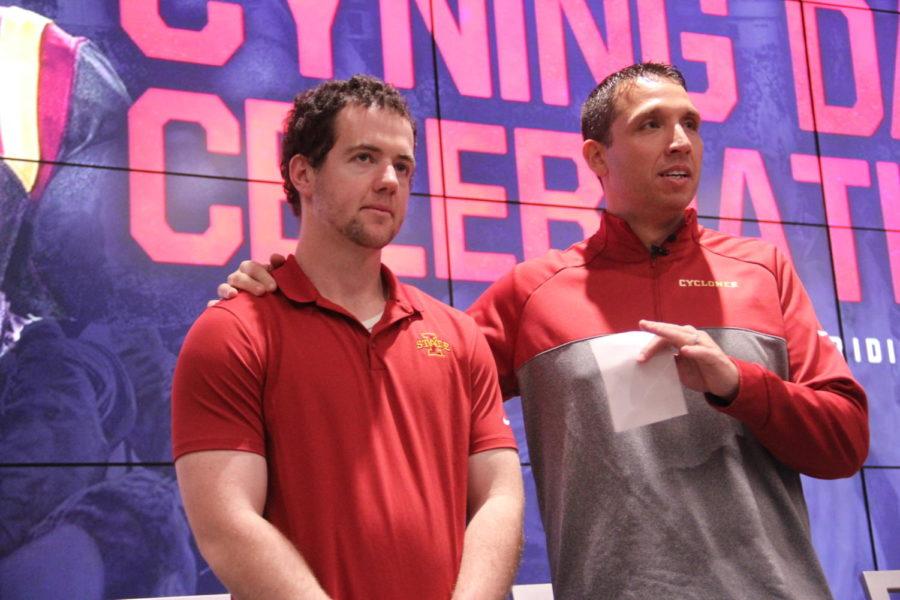Pinned deep; Corey Dunn’s first five games as a Cyclone
October 11, 2018
Corey Dunn’s punting career at Iowa State didn’t exactly start as well as he hoped.
For his first punt, Dunn was backed into his own end zone at Kinnick Stadium in Iowa City, Iowa. Redshirt senior quarterback Kyle Kempt had just been sacked at Iowa State’s 7-yard line, and the Cyclones needed a big punt from Dunn to reverse field position.
Dunn’s punt sailed sideways, traveling just 14 yards before going out of bounds at Iowa State’s 21.
His second punt went 37 yards. Punt No. 3 was just like the first one, spiraling 13 yards and setting Iowa up at the Iowa State 28-yard line.
After the game, coach Matt Campbell was frank about the field position battle, which Iowa State lost.
“You don’t want to try to expose yourself, especially against these guys,” Campbell said. “When you play these guys, they make you beat yourself.”
Dunn rebounded with a 58-yard punt later in the game to pin Iowa at its own 6-yard line, but the rocky start led to questions about Iowa State’s special teams.
—
“Kicking comes natural to us [Australians],” Dunn said. “Just like it does with quarterbacks throwing the football. It’s just natural.”
Dunn grew up playing Australian Rules Football, a sport where kicking with both feet is a necessity.
There’s also a lot of kicking on the run, unlike American football. That allows punters like Dunn, and former Texas punter Michael Dickson, to train better than most Americans. As redshirt sophomore kicker Connor Assalley noted, most high schools don’t have a coach who knows how to teach punting or kicking.
However, that also means there’s an adjustment for Dunn.
“I prefer kicking on the run,” Dunn said. “I’m slowly getting used to kicking off two steps. I’m not used to it as much.”
Dunn said the transition has been difficult.
The mechanics of punting American football-style are more compact. He’s had to work on not overstriding on his first step, which can throw things off balance.
For Dunn, one of the keys to the transition was watching other Australian punters.
He watched Blake O’Neill (Michigan), Tom Hackett and Mitch Wishnowsky (both at Utah), who were making the same adjustment as him.
Most of the Australian punters, like Dunn, enrolled at Prokick Australia. Prokick is more or less an international punting factory, which has produced some of the best punters in college football. For the last five years, the Ray Guy Award — given to the nation’s best college punter — has gone to an Australian.
“What Corey does really well is he’s really accurate,” said Joe Houston, special teams coordinator. “Growing up playing Australian Rules Football, he can place balls with tremendous accuracy. It almost looks like something threw the football, he’s that accurate.”
That accuracy has shown in recent weeks after Dunn’s rocky start.
In Iowa State’s win over Oklahoma State last week, Dunn punted the ball six times. Four of those were downed inside the Cowboys’ 20-yard line. His punting average was 41 yards per punt, but that includes a time when Dunn was forced to punt from the Oklahoma State 35. He pinned the Cowboys at their 13-yard line.
The fourth quarter against Oklahoma State was perhaps his biggest showing as a Cyclone.
With Iowa State leading by five with under 10 minutes to play, Dunn booted a 51-yard punt that went out of bounds at the Oklahoma State 12-yard line. Then, with a 13-point lead and four minutes to go, Iowa State had another drive stall at the 43-yard line. Dunn’s 39-yard punt stopped at the Oklahoma State 4-yard line, giving the Cowboys a long field ahead for their comeback, which fell short.
So far, 12 of Dunn’s 26 punts have landed inside the opponent’s 20. None of his punts have gone for touchbacks.
“We’re finding ways to challenge him and maximize his full potential,” Houston said. “But what he does is really impressive and he’s really dynamic.”
















